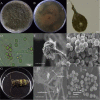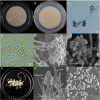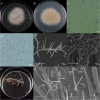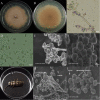Discovery of entomopathogenic fungi across geographical regions in southern China on pine sawyer beetle Monochamus alternatus and implication for multi-pathogen vectoring potential of this beetle
- PMID: 36643293
- PMCID: PMC9832029
- DOI: 10.3389/fpls.2022.1061520
Discovery of entomopathogenic fungi across geographical regions in southern China on pine sawyer beetle Monochamus alternatus and implication for multi-pathogen vectoring potential of this beetle
Abstract
Entomopathogen-based biocontrol is crucial for blocking the transmission of vector-borne diseases; however, few cross-latitudinal investigations of entomopathogens have been reported for vectors transmitting woody plant diseases in forest ecosystems. The pine sawyer beetle Monochamus alternatus is an important wood borer and a major vector transmitting pine wilt disease, facilitating invasion of the pinewood nematode Bursaphelenchus xylophilus (PWN) in China. Due to the limited geographical breadth of sampling regions, species diversity of fungal associates (especially entomopathogenic fungi) on M. alternatus adults and their potential ecological functions have been markedly underestimated. In this study, through traditional fungal isolation with morphological and molecular identification, 640 fungal strains (affiliated with 15 genera and 39 species) were isolated from 81 beetle cadavers covered by mycelia or those symptomatically alive across five regional populations of this pest in southern China. Multivariate analyses revealed significant differences in the fungal community composition among geographical populations of M. alternatus, presenting regionalized characteristics, whereas no significant differences were found in fungal composition between beetle genders or among body positions. Four region-representative fungi, namely, Lecanicillium attenuatum (Zhejiang), Aspergillus austwickii (Sichuan), Scopulariopsis alboflavescens (Fujian), and A. ruber (Guangxi), as well as the three fungal species Beauveria bassiana, Penicillium citrinum, and Trichoderma dorotheae, showed significantly stronger entomopathogenic activities than other fungi. Additionally, insect-parasitic entomopathogenic fungi (A. austwickii, B. bassiana, L. attenuatum, and S. alboflavescens) exhibited less to no obvious phytopathogenic activities on the host pine Pinus massoniana, whereas P. citrinum, Purpureocillium lilacinum, and certain species of Fusarium spp.-isolated from M. alternatus body surfaces-exhibited remarkably higher phytopathogenicity. Our results provide a broader view of the entomopathogenic fungal community on the vector beetle M. alternatus, some of which are reported for the first time on Monochamus spp. in China. Moreover, this beetle might be more highly-risk in pine forests than previously considered, as a potential multi-pathogen vector of both PWN and phytopathogenic fungi.
Keywords: Monochamus alternatus; Pinus massoniana; biological control; cross-latitudinal; entomopathogenic fungi; multi-pathogen vector.
Copyright © 2022 Wu, Wu, Wang, Qu, He, Wang, Cheng, Zhang and Cheng.
Conflict of interest statement
The authors declare that the research was conducted in the absence of any commercial or financial relationships that could be construed as a potential conflict of interest.
Figures







Similar articles
-
Associated bacteria of a pine sawyer beetle confer resistance to entomopathogenic fungi via fungal growth inhibition.Environ Microbiome. 2022 Sep 9;17(1):47. doi: 10.1186/s40793-022-00443-z. Environ Microbiome. 2022. PMID: 36085246 Free PMC article.
-
Invasion History of the Pinewood Nematode Bursaphelenchus xylophilus Influences the Abundance of Serratia sp. in Pupal Chambers and Tracheae of Insect-Vector Monochamus alternatus.Front Plant Sci. 2022 May 20;13:856841. doi: 10.3389/fpls.2022.856841. eCollection 2022. Front Plant Sci. 2022. PMID: 35668811 Free PMC article.
-
Management of overwintering pine sawyer beetle, Monochamus alternatus with colonized Beauveria bassiana ERL836.PLoS One. 2022 Sep 2;17(9):e0274086. doi: 10.1371/journal.pone.0274086. eCollection 2022. PLoS One. 2022. PMID: 36054240 Free PMC article.
-
Insights into the Role of Fungi in Pine Wilt Disease.J Fungi (Basel). 2021 Sep 20;7(9):780. doi: 10.3390/jof7090780. J Fungi (Basel). 2021. PMID: 34575818 Free PMC article. Review.
-
Interspecific communication between pinewood nematode, its insect vector, and associated microbes.Trends Parasitol. 2014 Jun;30(6):299-308. doi: 10.1016/j.pt.2014.04.007. Epub 2014 May 5. Trends Parasitol. 2014. PMID: 24810363 Review.
Cited by
-
Molecular Mechanisms of the Biological Control of Pine Wilt Disease Using Microorganisms.Microorganisms. 2025 May 26;13(6):1215. doi: 10.3390/microorganisms13061215. Microorganisms. 2025. PMID: 40572104 Free PMC article. Review.
-
Entomopathogenic fungi in crops protection with an emphasis on bioactive metabolites and biological activities.World J Microbiol Biotechnol. 2024 May 29;40(7):217. doi: 10.1007/s11274-024-04022-x. World J Microbiol Biotechnol. 2024. PMID: 38806748 Review.
-
Pestalotiopsis jiangsuensis sp. nov. Causing Needle Blight on Pinus massoniana in China.J Fungi (Basel). 2024 Mar 21;10(3):230. doi: 10.3390/jof10030230. J Fungi (Basel). 2024. PMID: 38535238 Free PMC article.
-
Potential Functions and Transmission Dynamics of Fungi Associated with Anoplophora glabripennis Across Different Life Stages, Between Sexes, and Between Habitats.Insects. 2025 Mar 5;16(3):273. doi: 10.3390/insects16030273. Insects. 2025. PMID: 40266779 Free PMC article.
References
-
- Aphidech S., Kusavadee S. (2013). Isolation, identification, culture and production of adenosine and cordycepin from cicada larva infected with entomopathogenic fungi in Thailand. Afr. J. Microbiol. Res. 7 (2), 137–146. doi: 10.5897/AJMR12.1038 - DOI
LinkOut - more resources
Full Text Sources
Miscellaneous

